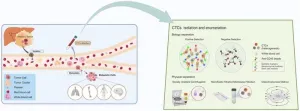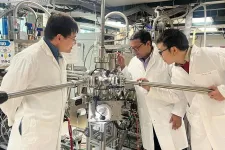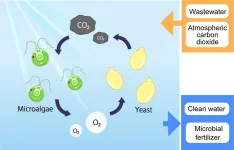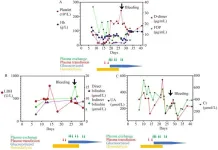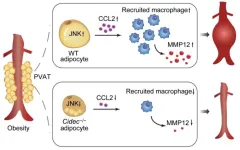(Press-News.org)
From November 11 to 12, the Fortune Global Forum 2024, an invite-only premier event of Fortune, is set to gathers the leaders of the world’s biggest multinational companies on the dynamic frontiers of global business in New York, where business leaders from around the globe come together to create a modern roadmap for success.
Insilico Medicine(“Insilico”), a global leading generative artificial intelligence (AI)-driven biotechnology company, announces that Alex Zhavoronkov PhD, founder and CEO of Insilico Medicine will be attending the Fortune Global Forum 2024, participating in the panel titled “Rewiring Business: Unlocking AI’s Full Economic Potential” at 12:05-1:20 pm ET, November 12.
Focusing on the strategy to both adopt AI at speed and scale and harness its potential for economic growth and competitive advantage, the session is moderated by Andrew Nusca, Editorial Director of Fortune Live Media, featuring Barbara Humpton, President and CEO of Siemens, Timothy Wennes, Chief Executive Officer of Santander US, and Rodney Zemmel, Senior Partner and Global Leader of Digital and Firmwide AI at McKinsey & Company.
Since 1995, the Fortune Global Forum has convened in the world’s top business capitals, providing opportunities to connect with exceptional leaders and shape the future of global business. This November in New York, the brightest minds gather from the world’s largest and most innovative companies, including the Fortune Global 500.
In 2016, Insilico first described the concept of using generative AI for the design of novel molecules in a peer-reviewed journal, which laid the foundation for the commercially available Pharma.AI platform. Since then, Insilico keeps integrating technical breakthroughs into Pharma.AI platform, which is currently a generative AI-powered solution spanning across biology, chemistry and clinical development. Powered by Pharma.AI, Insilico has nominated 19 preclinical candidates in its comprehensive portfolio of over 30 assets since 2021 and has received IND approval for 9 molecules.
In early 2024, Insilico published a Nature Biotechnology paper presenting the entire R&D journey from AI algorithms to Phase II clinical trials of ISM001_055, the company’s lead drug pipeline with AI-discovered target and AI-designed structure. Following that, Insilico has recently announced positive preliminary results from a Phase IIa trial (NCT05938920), where ISM001_055 showed dose-dependent response in forced vital capacity (FVC), after only 12 weeks of dosage.
About Insilico Medicine
Insilico Medicine, a global clinical stage biotechnology company powered by generative AI, is connecting biology, chemistry and clinical trials analysis using next-generation AI systems. The company has developed AI platforms that utilize deep generative models, reinforcement learning, transformers and other modern machine learning techniques for novel target discovery and the generation of novel molecular structures with desired properties. Insilico Medicine is developing breakthrough solutions to discover and develop innovative drugs for cancer, fibrosis, immunity, central nervous system diseases, infectious diseases, autoimmune diseases, and aging-related diseases. www.insilico.com
END
Hepatocellular carcinoma (HCC) is a significant global health concern, particularly in regions like the Asia-Pacific, where chronic viral hepatitis and liver diseases contribute to its high incidence and mortality. Despite medical advancements, the late-stage diagnosis of HCC remains a major challenge, which underscores the need for more effective early detection strategies. Circulating tumor cells (CTCs), which are tumor cells released into the bloodstream from primary neoplastic sites, offer a promising avenue for non-invasive cancer diagnostics. This review provides a comprehensive overview of CTC detection methods, ...
MINNEAPOLIS / ST. PAUL (11/08/2024) — Researchers at the University of Minnesota have achieved a new material that will be pivotal in making the next generation of high-power electronics faster, transparent and more efficient. This artificially designed material allows electrons to move faster while remaining transparent to both visible and ultraviolet light, breaking the previous record.
The research, published in Science Advances, a peer-reviewed scientific journal, marks a significant leap forward in semiconductor ...
As air temperatures stay elevated through fall months, people may still want clothes that cool them down while outside, especially if they live in cities that stay warmer than rural landscapes. Researchers who previously demonstrated a cooling fabric coating now report on additional tests of a treated polyester fabric in ACS Applied Materials & Interfaces. Fabric treated with the team’s chalk-based coating kept the air underneath up to 6 degrees Fahrenheit cooler in warmer urban environments.
Researchers Evan D. Patamia, Megan K. Yee and Trisha L. ...
As cancer cells grow, they pump out metabolic byproducts such as lactic acid into the tumor microenvironment. Exhausted T cells — which have lost their cancer-fighting oomph — consume this lactic acid, which further saps their energy, according to new research from the University of Pittsburgh and UPMC Hillman Cancer Center.
When the researchers blocked the protein that imports lactic acid into cells, exhausted T cells gained a new lease on life, which led to improved tumor control in mouse models of cancer. The findings are published today in Nature Immunology.
“Blocking access to inhibitory metabolites is a completely new take on how we can reinvigorate ...
Only a few weeks ago, massive precipitation produced by the storm “Boris” led to chaos and flooding in Central and Eastern Europe. An analysis conducted by the Alfred Wegener Institute shows that in a world without the current level of global warming Boris would have deposited roughly nine percent less rain. Such conclusions can be drawn thanks to a new modelling approach called ‘storylines’. How it can be used in near-real-time was just presented in the Nature journal Communications Earth & Environment. At the same time, the AWI team released a freely available online tool that ...
Researchers today (Nov. 8, 2024) are releasing the flagship dataset from an ambitious study of biomarkers and environmental factors that might influence the development of type 2 diabetes. Because the study participants include people with no diabetes and others with various stages of the condition, the early findings hint at a tapestry of information distinct from previous research.
For instance, data from a customized environmental sensor in participants’ homes show a clear association between disease state and exposure to tiny particulates of pollution. ...
Culturing, a term for growing microorganisms in the laboratory, is a basic yet indispensable method in microbiology research. Microorganisms are often cultured in a liquid medium that provides essential nutrients, and this process is both simple and highly effective. In addition to nutrients, oxygen availability is also critical for the growth of aerobic microorganisms. However, oxygen does not dissolve easily in the liquid medium. As a result, the medium needs to be forcibly aerated, usually by shaking.
Several techniques have been developed for better aeration of “shake” cultures, including “baffled” shake flasks, which have indentations designed to improve oxygen ...
Bakeries and wineries can’t do without yeast, but they have no need for green algae. Wastewater treatment facilities, however, might just want to have these microorganisms team up. Osaka Metropolitan University researchers have discovered that these simple organisms form the best combination in terms of boosting wastewater treatment efficiency.
The active sludge method of wastewater treatment requires electricity to ensure the flow of oxygen that feeds bacteria and other organisms that process the water. Adding microalgae ...
The COVID-19 pandemic has prompted the rapid development and administration of various vaccines worldwide, with some reports linking these vaccines to immune thrombotic thrombocytopenic purpura (TTP). This report presents two cases of TTP occurring after the administration of the inactivated vaccine CoronaVac from Sinovac Biotech, highlighting the potential association between this type of vaccine and TTP. The article also provides an analysis of TTP incidence in the Nanjing area of China, suggesting a possible correlation between COVID-19 vaccination and the occurrence of TTP.
The first case details a 23-year-old female who developed symptoms of TTP three days ...
Abdominal aortic aneurysm (AAA) is a degenerative lesion characterized by structural disruption of the abdominal aortic wall and progressive dilatation into a pulsatile mass. AAA is strongly associated with obesity, partly due to abnormal dilatation of perivascular adipose tissue (PVAT) in the abdomen, however, direct evidence is still lacking.
Cell death-inducing DNA fragmentation factor-like effector C (CIDEC), also known as fat-specific protein 27 (FSP27) in rodents, is a lipid droplet (LD)-associated protein that plays an important role in lipid storage. It has been reported that CIDEC/FSP27 promotes the growth of LDs by mediating the exchange and transfer of lipids ...

